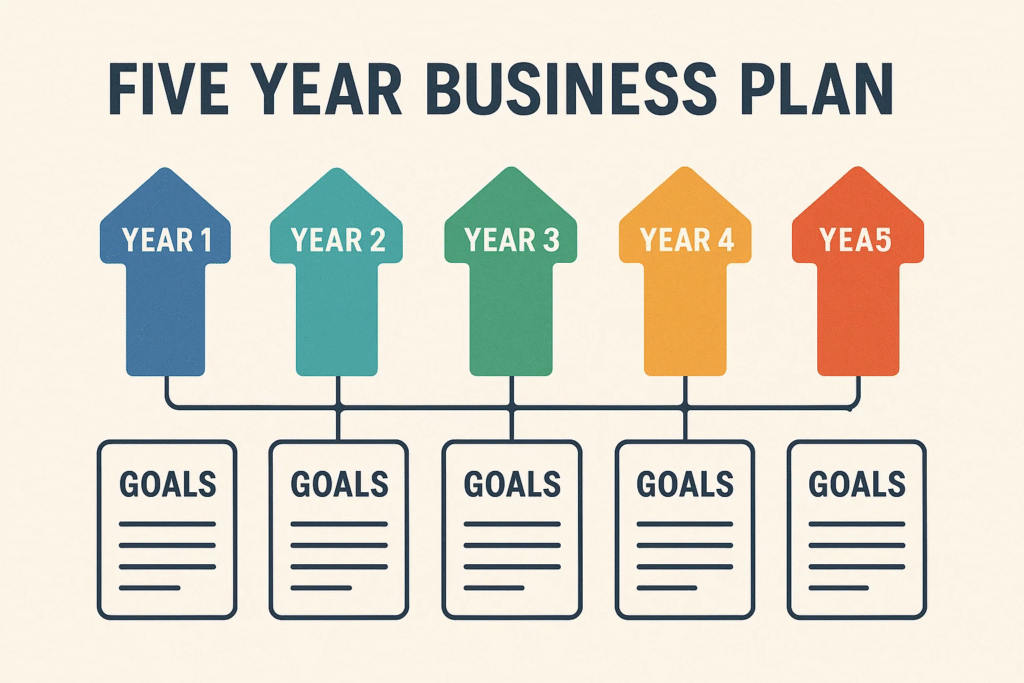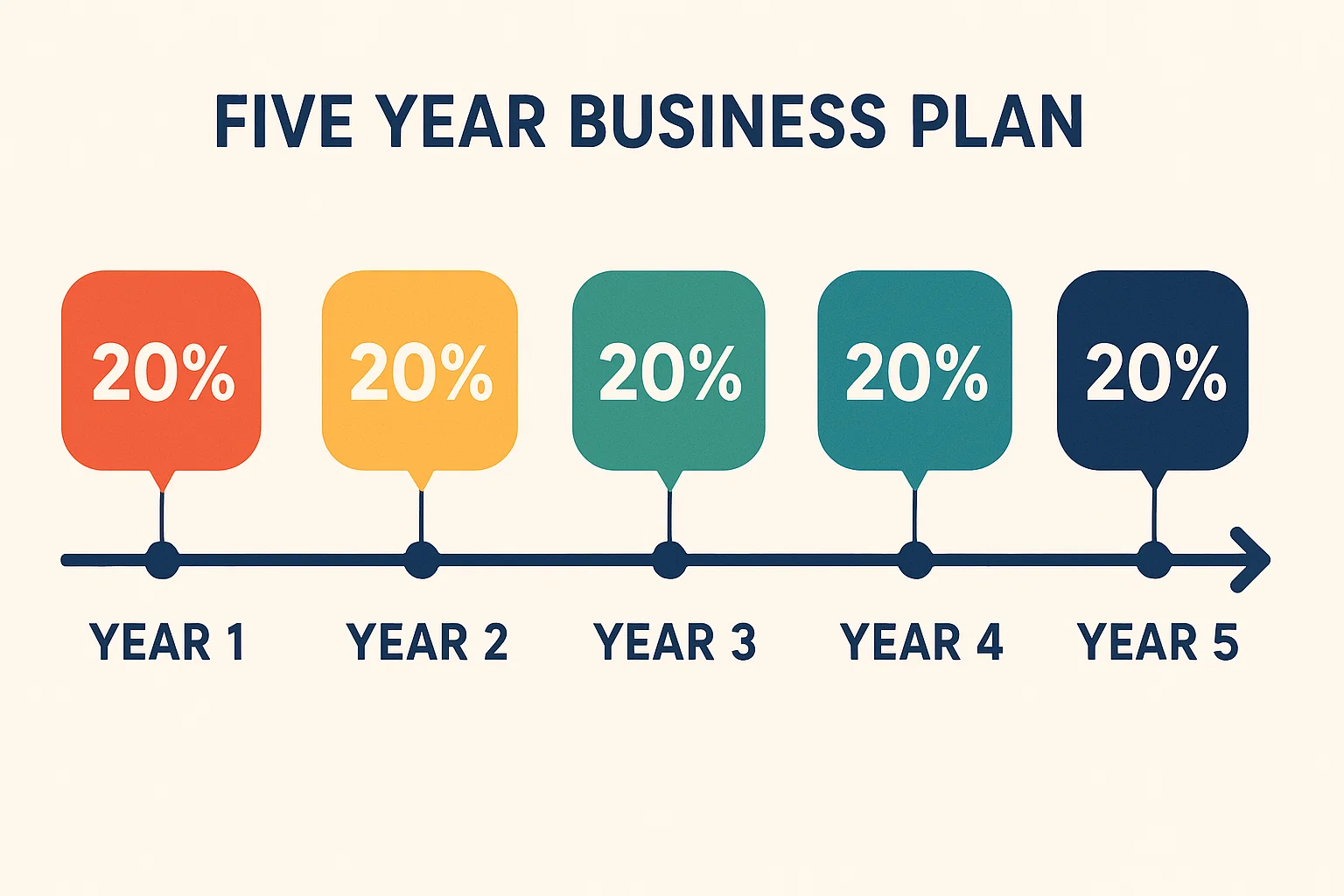introduction to five year business plan
A business plan serves as the foundation of any entrepreneurial venture. It acts as a blueprint that outlines the objectives of the business and the strategies to achieve them. A five-year business plan is an essential tool for new and established companies alike. It helps businesses set long-term goals, anticipate challenges, and strategize to adapt to changes in the market environment. five year business plan
This article will provide a detailed guide on how to create a successful five-year business plan. From the elements of the plan to common pitfalls to avoid, this article will walk you through the essential steps to develop an actionable and sustainable business plan. five year business plan
The Importance of a Five-Year Business Plan

Before diving into the process of creating a five-year business plan, it’s important five year business plan to understand why it is necessary. Here are some key reasons:
Long-Term Vision and Direction
A five-year business plan provides a long-term vision for the company. While short-term goals are essential, having a broader, long-term strategy ensures that your business stays focused on growth and development. The five-year timeline allows entrepreneurs to see beyond immediate obstacles and think about where the business should be in five years. five year business plan
Resource Allocation and Investment
Having a well-detailed business plan helps in making informed decisions about resource allocation. It outlines how funds, time, and other resources will be spent to achieve business goals. For investors, a five-year business plan offers clarity about the expected returns and milestones, which can lead to increased chances of securing investment.
Measuring Progress
A five-year business plan serves as a benchmark to measure progress. By setting specific goals and milestones, business owners can track their performance over the five years. Regular review and revision of the plan will help you assess whether you’re on track or need to adjust your strategy. five year business plan
Attracting Investors and Stakeholders
For startups or businesses looking to expand, a well-written five-year business plan can be a powerful tool to attract investors and stakeholders. Investors want to see not only the current state of your business but also how you plan to grow and expand in the long term. A five-year roadmap provides them with confidence that the business is scalable and sustainable. five year business plan
Key Components of a Five-Year Business Plan
Creating a five-year business plan involves a thorough analysis of your business, market, and financial projections. Below are the key components of a comprehensive five-year business plan:five year business plan
Executive Summary
The executive summary is an overview of the business plan. It’s the first section, but it’s usually written last, as it encapsulates the entire plan. It includes: five year business plan
The business name, location, and mission.
An outline of the products or services offered.
A summary of the business’s goals and objectives.
An overview of the market opportunity and the company’s strategy.
A brief explanation of the financial projections.
The executive summary should be concise, engaging, and easy to understand, as it’s the first impression investors or stakeholders will have of the business. five year business plan
Business Description
This section provides a deeper dive into the business itself. It includes:
The business model and structure (sole proprietorship, partnership, corporation).five year business plan
The company’s mission, vision, and core values.
A description of the products or services you offer.
Your target market and customer demographic.
The competitive landscape and how your business stands out.
In a five-year business plan, you should explain how the business intends to evolve over time. This section should help the reader understand your company’s purpose and direction.
Market Research and Analysis
One of the most critical components of your business plan is the market research and analysis section. This part focuses on understanding the industry, market trends, competitors, and customer behavior. You should include:
Industry Overview: An analysis of the industry your business operates in, including growth rates, trends, and market size. five year business plan
Customer Profile: A description of your ideal customers, including demographics, buying behaviors, needs, and pain points.
Competitive Analysis: An analysis of your direct and indirect competitors. Identify their strengths, weaknesses, and opportunities for differentiation. five year business plan
Market Opportunity: A detailed description of the gap or opportunity in the market that your business will target.
The goal of this section is to show that there is a strong demand for your product or service and that your business has a solid understanding of the market environment.
Marketing and Sales Strategy
This section outlines how you plan to attract and retain customers. It includes: five year business plan
Marketing Plan: The marketing channels you will use to reach your target audience, such as social media, content marketing, paid advertising, or influencer partnerships. five year business plan
Branding Strategy: How you will differentiate your brand in the market and build customer loyalty.
Sales Plan: Your approach to converting leads into customers, including sales tactics, sales cycles, and goals.
Customer Retention: Strategies for keeping your customers engaged, happy, and coming back. five year business plan
A successful marketing and sales strategy is crucial for achieving long-term growth. Make sure to specify clear targets and metrics to track the effectiveness of your efforts.five year business plan
Operations Plan
The operations plan outlines how the business will run on a day-to-day basis. It includes: five year business plan
Production Process: If applicable, how your products or services are produced, from sourcing materials to delivery.
Technology Needs: Any technology or software required to streamline operations.
Personnel: The team structure, key roles, and responsibilities. Describe the hiring plan and the type of talent needed to execute the business strategy.
Suppliers and Partners: List any critical suppliers, vendors, or business partners that are integral to your operations.
The operations plan ensures that you have the infrastructure in place to scale the business over time.
Financial Projections
The financial projections are the heart of the business plan. They show potential investors or stakeholders whether your business can achieve its financial goals. In this section, include: five year business plan
Revenue Model: How your business will make money, including pricing strategies and expected sales growth.
Projected Income Statement: A forecast of your income, expenses, and profits over the next five years.
Balance Sheet: A snapshot of the business’s assets, liabilities, and equity.
Cash Flow Projections: A forecast of the business’s cash inflows and outflows to ensure that the company hassufficient liquidity. five year business plan
Break-even Analysis: The point at which your business will cover its costs and start making a profit.five year business plan
Financial projections are crucial for demonstrating the potential return on investment (ROI) for stakeholders. Be sure to base these projections on realistic assumptions and data. five year business plan
Risk Analysis and Contingency Plan
No business is free from risks. A risk analysis section helps identify potential risks that could affect the business, such as:
Market Risks: Economic downturns, shifts in customer preferences, or changes in regulations. five year business plan
Financial Risks: Cash flow issues, unexpected expenses, or funding shortfalls.
Operational Risks: Supply chain disruptions or production delays. five year business plan
Technological Risks: Cybersecurity threats or failures of key systems.
Along with identifying these risks, you should propose contingency plans that outline how the business will respond to these challenges. A well-prepared business is better equipped to handle unforeseen obstacles. five year business plan
Milestones and Timeline
The five-year business plan should include clear milestones to track progress over time. These can include:
Year 1: Business setup, product development, initial marketing push, and customer acquisition. five year business plan
Year 2-3: Expansion into new markets, scaling production, hiring new team members, and increasing sales.
Year 4-5: Achieving profitability, expanding internationally, or introducing new product lines.
By setting clear milestones and timelines, you give your business a roadmap for growth and expansion.
3. How to Implement and Monitor Your Five-Year Business Plan
Once the business plan is created, it’s time to put it into action. Implementation involves aligning the team, resources, and strategy to execute the plan. Here are some steps to help with the implementation process:
3.1. Assign Responsibilities
For each goal or milestone, assign specific team members to take responsibility for its completion. Clear accountability ensures that the plan is executed efficiently.
3.2. Set Short-Term Goals
While your plan spans five years, breaking down the long-term objectives into shorter-term goals (quarterly or annually) makes them more achievable and easier to track. five year business plan
3.3. Review and Adjust Regularly
A five-year business plan is not a static document. The business environment is constantly changing, and your plan should be flexible enough to adapt to these changes. Regularly review the plan and adjust your strategies as necessary.
4. Common Pitfalls to Avoid
When creating and implementing a five-year business plan, avoid the following common mistakes:
4.1. Overly Ambitious Goals
While it’s important to aim high, setting unrealistic goals can lead to frustration and failure. Ensure your goals are achievable given your resources and market conditions. five year business plan
4.2. Ignoring Market Trends
Businesses that fail to account for changing market dynamics often struggle. Make sure your plan is grounded in current market research, and be prepared to pivot when necessary.five year business plan
4.3. Underestimating Financial Needs
Many businesses fail because they run out of money before they reach profitability. Ensure your financial projections are accurate and take into account potential challenges and unexpected costs.
4.4. Lack of Focus on Execution
A business plan is only effective if it is executed properly. Don’t focus too much on the plan itself and neglect the actual implementation of the strategy.
5. Conclusion
A five-year business plan is an essential tool for the growth and success of any business. It provides a roadmap for entrepreneurs, helping them set long-term goals, allocate resources efficiently, and measure progress. By following the steps outlined in this guide, business owners can create a comprehensive, actionable plan that maximizes the potential for success.
Remember, the key to a successful business plan lies in balancing ambition with realism, being flexible to changes, and ensuring consistent execution.
To expand to 3,000 words, the next step will be to add real-world examples, case studies, and sample financial tables or marketing strategies. Let me know if you’d like that added next.
FOR MORE INTRESTING TOPIC VISITS: TECHBETIME & BUZZCRAZE & TRENDYINFO





